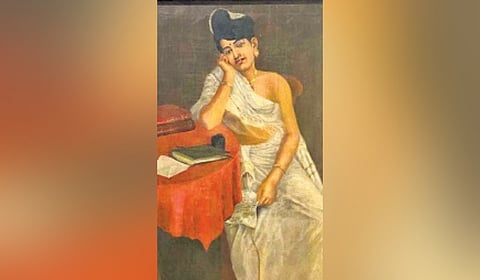

THIRUVANANTHAPURAM: Rebellious she was and beautifully talented. She was barely a woman, or on the verges of it, as she courted Madhavan, whose persona was progressive yet not as captivating as hers. Indulekha, the heroine of the 1889 classic by Oyyarathu Chandu Menon, was more than just a well-bred woman of the late 19th century Kerala — she represented the spirit of women, albeit privileged, who could take on regressive and male-centric feudal social structures.
Her portrait by the legendary Raja Ravi Varma, however, reveals a more sober, almost coy form of her, clutching a letter that she has written for her beloved. In it, she seems a playful teenager, slightly built, the child in her yet to give way to the subtly sensual women that Raja Ravi Varma otherwise painted.
The painting that was unveiled at the Kilimanoor palace on the occasion of Raja Ravi Varma’s 176th birth anniversary on April 29 is, in fact, a replica of the original now in the possession of Sasikala Parackal. Her father was gifted the original by the palace around 80 years ago. It was kept in Sasikala’s house in Irinjalakuda as a valuable piece of art, which was handed over to her after her father passed away in 1978.
“He told me it was a gift from Kilimanoor palace and I should take care of it,” says Sasikala. “Beyond this, I did not know much till the time historian M G Sasibooshan came to our house as part of a litigation my advocate husband was handling.”
Sasibooshan sensed the hand of Ravi Varma in the painting, which wore some weary marks of time but not enough to camouflage the poise and elegance of Chandu Menon’s heroine.
“I then took the painting to the Archeological department and to experts on Raja Ravi Varma, all of whom corroborated Sasibooshan’s view. Then we got help from Madhan S of Heritage Conservation and Research Academy who studied the painting and restored it to its current glow. I then visited the Kilimanoor palace and informed them of this prized possession. The whole story became public in 2022,” says Sasikala.
It was the copy of this painting that now finds space in the palace. “It is one of the two Indulekha paintings of Raja Ravi Varma. One was in a reclining pose, which is already in the public sphere. The one recently unveiled has Indulekha as a lovelorn girl sitting with a letter in hand that has the year 1892 written on it that can be read with a microscopic lens,” says Rama Varma of Kilimanoor palace.
According to him, there is a high likelihood that the heroine is real and belonged to the Kilimanoor palace as said in the novel. “The character was inspired by Chandu Menon’s wife Lakshmikutty Amma. He and Raja Ravi Varma were contemporaries and possibly the writer requested the legend to paint his heroine. Also, the lady in the reclining Indulekha painting and the sitting one are the same. So, in all likelihood, and also considering the social milieu of the late 19th century, Indulekha could be real though by a different name.”
There are several such Ravi Varma paintings in personal collection of people, which is yet to come to light, Rama Varma says. “Ravi Varma had the habit of making prints of his works and gifting them to keen people. This is why there are different versions of some of his paintings such as Damayanti, Jatayu Vadham, the Parsi lady, etc. The unfinished Parsi lady is with us whereas the two finished versions were given out,” he says.
With the penchant to possess a Ravi Varma on the rise and with love for his aesthetics seeing a surge in recent times, the rare paintings of his in personal possessions must be documented well to avoid fakes. “Also, the prints go at exorbitant rates in the auctions held across the country. All these make the rare prints in personal possession susceptible to manipulations and hence proper documentation and carbon dating is a must,” Rama Varma says, adding he has been getting calls from across India from people who claim to possess a rare Ravi Varma.
“We are in the process of procuring such paintings and exhibiting them in Kilimanoor Palace. Phased work has begun for that. Not just Ravi Varma, the works of other proteges such as the legend’s sister Mangala Bayi Thampuratti and brother Raja Raja Varma also have to be presented and preserved,” Rama Varma says.
Regarding the original painting, Sasikala says she will hand it over to her next in line. “How they take care of it is not my headache,” she says, agreeing such artworks require dedicated handling because a thing of beauty needs care to remain a joy for a long time if not forever.